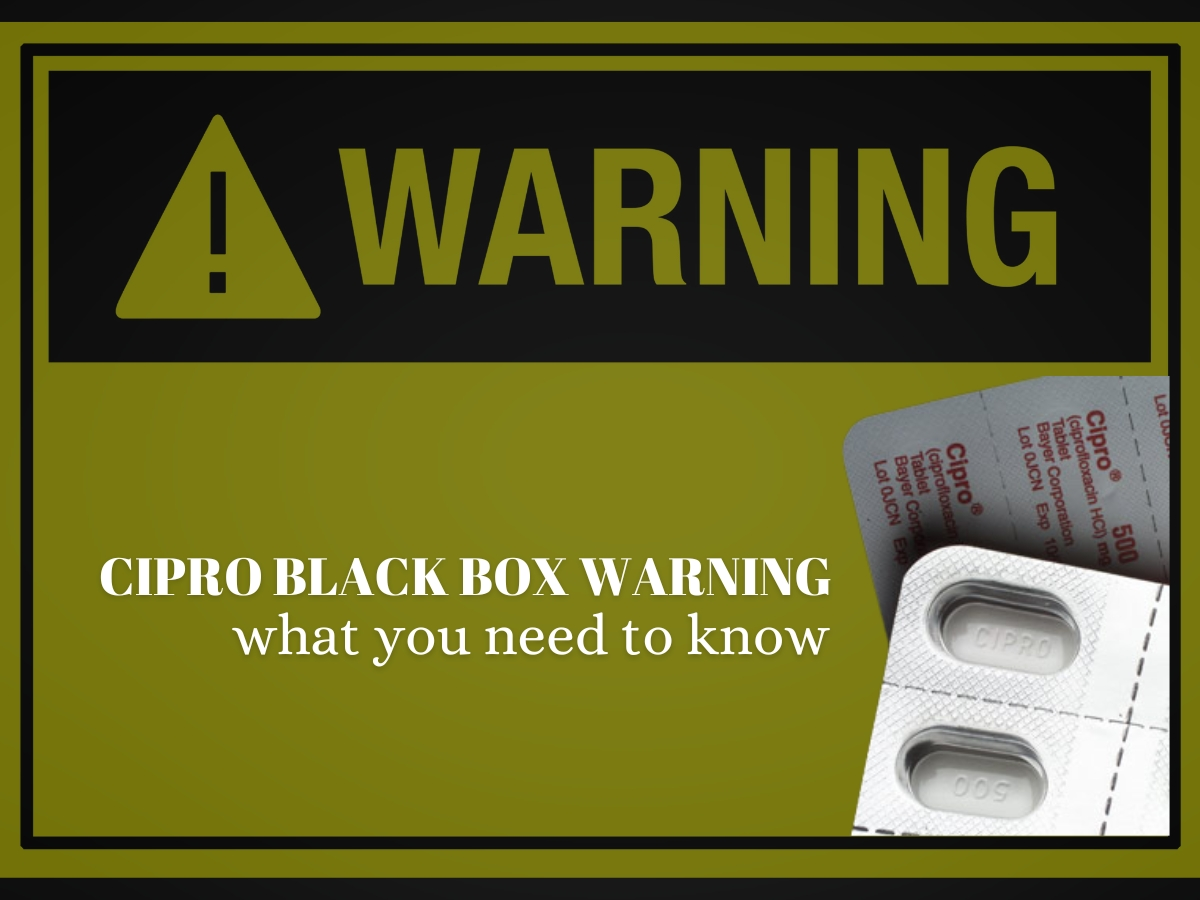Recently, you may have encountered conversations surrounding the Cipro black box warning, prompting questions about its relevance to your health. This advisory is a pivotal piece of information with substantial consequences for your medical journey. Understanding the nuances of this warning is essential, as it can significantly shape the decisions made regarding your healthcare.
Delving into the details of the Cipro black box warning equips you with the knowledge to navigate this antibiotic’s potential risks and benefits. It serves as a guiding light, steering conversations with healthcare providers and contributing to an informed approach to your overall well-being.
What Are the Basics of Ciprofloxacin?
Ciprofloxacin, commonly recognized as Cipro, is an antibiotic in the fluoroquinolone class. Widely prescribed, it effectively treats various bacterial infections, from urinary tract issues to respiratory ailments. Physicians favor Cipro for its ability to combat a broad spectrum of bacteria.
As a fluoroquinolone, Cipro works by inhibiting bacterial DNA replication, thereby impeding the spread of infection. Its versatility and potency make it a go-to choice in the medical field.
However, it’s crucial to consider the potential risks associated with its usage, especially in light of the Cipro Black Box Warning issued by the FDA. Understanding the basics of Ciprofloxacin equips patients and healthcare providers alike with the knowledge needed to make informed decisions about its use in managing bacterial infections.
What Exactly is a Black Box Warning?
Let’s explore the term causing concern among healthcare experts and patients alike – the Black Box Warning.
In simple terms, it’s the most severe caution issued by the U.S. Food and Drug Administration (FDA) to alert the public and healthcare providers about significant risks tied to a specific drug. This stark warning, symbolized by a black box on the drug’s label, serves as a crucial signal that the associated risks are serious and require heightened attention.
It’s a spotlight on potential dangers, emphasizing the importance of understanding and considering these risks before choosing a particular medication. The Ciprofloxacin black box warning sheds light on the potential for severe side effects, urging individuals and healthcare professionals to weigh the benefits against the risks.
Who Are at Risk With the Ciprofloxacin Black Box Warning?
Recognizing the groups that may be more susceptible to potential side effects is of utmost importance. Although anyone could experience these adverse effects, specific demographics seem to be at a heightened risk.
This includes individuals aged 60 and above, those currently using corticosteroid medications, and individuals with a history of organ transplantation. Understanding these risk factors allows a more informed approach to medication decisions and fosters proactive healthcare discussions.
Black Box Warnings Issued by FDA Related to Fluoroquinolones
Since 2008, the FDA has issued several crucial safety warnings regarding fluoroquinolones, called black box warnings. These warnings represent the most severe cautionary measures the FDA can attach to prescription medications.
Let’s delve into these warnings and the respective years they were brought to light.
2008: Tendinitis & Tendon Rupture
In 2008, the FDA sounded the alarm on the risk of tendon inflammation (tendonitis) and rupture associated with fluoroquinolones. Notably, individuals over 60 years old, those with kidney, heart, or lung transplants, and individuals undergoing steroid treatment face a higher risk. If you notice symptoms such as tendon pain or swelling, it is crucial to inform your healthcare provider promptly. They may advise discontinuing fluoroquinolone use.
2011: Worsening of Myasthenia Gravis Symptoms
In 2011, the FDA cautioned against fluoroquinolones in individuals with Myasthenia Gravis (MG), an autoimmune condition causing muscle weakness. Fluoroquinolones can exacerbate muscle weakness in MG, potentially leading to breathing difficulties and, in severe cases, death. The worsening of MG symptoms could manifest at any point after initiating fluoroquinolone treatment.
2013: Nerve Damage
Adding to the black box warnings, in 2013, the FDA highlighted the risk of peripheral neuropathy associated with fluoroquinolones. Peripheral neuropathy involves nerve damage outside the brain and spinal cord and can occur anytime during fluoroquinolone treatment. If symptoms of neuropathy, such as burning, tingling, or painful sensations in the arms or legs, arise, immediate communication with your healthcare provider is essential. While discontinuation of fluoroquinolone use is likely, neuropathy may persist for months to years or even become permanent.
2016: Limited Use of Fluoroquinolones
In 2016, the FDA advised against using fluoroquinolones for mild infections, recommending their preservation for situations where no alternative treatment options exist. This caution stems from the potential for fluoroquinolones to cause serious side effects affecting tendons, muscles, joints, nerves, and the brain.
Mood and behavioral changes, including nervousness, agitation, confusion, depression, psychosis, and even suicidal thoughts or behaviors, have been linked to their use. If you observe any alterations in your mood or behavior, it’s crucial to contact your healthcare provider.
Additional Safety Warnings (2018)
In July 2018, the FDA reiterated concerns about mental health issues tied to fluoroquinolones, including severe brain side effects. Loss of consciousness or seizures warrants immediate emergency care. The warning also encompassed information about blood sugar problems, presenting as low (hypoglycemia) or high blood sugar (hyperglycemia). Hypoglycemia, particularly dangerous as it can lead to a coma, is more likely in individuals taking diabetes medications that lower blood sugar or those of older age.
In December 2018, the FDA issued another warning, emphasizing a heightened risk of aortic ruptures (tears) that could lead to dangerous bleeding and potential fatality. Those with a history of blockages or aneurysms in any blood vessel, high blood pressure, or medical conditions affecting blood vessels are at an increased risk.
Conclusion
The Cipro Black Box Warning is a crucial reminder that commonly prescribed medications can have potential risks. It underscores the significance of making well-informed decisions in healthcare. If you ever face a scenario where Cipro is being considered, initiating a comprehensive conversation with your healthcare provider is essential. Your health is of utmost importance, and comprehending the implications of the Cipro Black Box Warning is a key stride toward guaranteeing a treatment course that is both safe and effective.
If you’re also using Cipro and are worried about its consequences, don’t hesitate to contact the professionals of Regenerative Masters.
FAQs
Is Cipro a toxic antibiotic?
The Food and Drug Administration (FDA) and the European Medicines Agency (EMA) have flagged three fluoroquinolones—ciprofloxacin, levofloxacin, and moxifloxacin—as having a significant association with neuropsychiatric toxicity. This includes alarming risks such as suicide, aortic dissections/aneurysms, and the potential for long-term disability.
Why is Cipro banned?
Fluoroquinolone medications, including ciprofloxacin, levofloxacin, lomefloxacin, moxifloxacin, norfloxacin, ofloxacin, pefloxacin, prulifloxacin, and rufloxacin, have the potential to induce enduring, incapacitating, and possibly irreversible side effects affecting tendons, muscles, joints, and the nervous system.
What is the lawsuit against Cipro?
Patients who experienced harmful side effects following the use of Cipro®, Levaquin®, or Avelox® have initiated numerous claims. Many of these legal actions assert that the manufacturers deliberately withheld information from the public regarding the safety of these medications.

